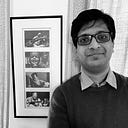Strings that crossed the Vindhyas
Manchala Jagannadha Rao and Angamali Jose
First the discovery
When you’ve been devouring an art form for a while (say a couple of decades), studying it on and off, and writing about it in your free time, it rarely takes you completely by surprise. Rarely.
Yesterday, I came across this innocuous looking tweet:
I had not heard of or heard this vainika until yesterday. And this is not someone of deep-yesteryear — this person was most active in the second half of the last century, well into the recording and broadcast age. Listen to the piece provided in the tweet:
He precedes the kriti (listed as Joojavane, one I am unfamiliar with) with an alapana and tanam. And follows up with an extensive kalpanaswara passage which is quite staccato feel about it with each round of swaras extending over several tala cycles. The combined effect is almost dhrupad-like in its pulsar intensity.
Then the treasure
The uploader of the piece has also provide a link to a website dedicated to Manchala Jagannadha Rao. And in it we see the outline of a remarkable life.
A boy is fully sighted until the age five. Then he contracts small pox. He loses all sight in one eye, and severely damages another. [My son is about to turn five — I cannot imagine how devastating this would be for a child and his family]. He pours himself into Carnatic music and the veena. By mid-life, all sight is gone. The music stays and becomes all. His brother gives up his career to support the artistry and ambitions of the musician. He joins All India Radio as a producer and traverses the country. In the midst of all this, he meticulously researches and publishes works on composers such as Thyagaraja, Annamacharya and Bhadrachala Ramadas. He is honored by universities and AIR bestows upon him the title of Producer Emeritus.
So far, so very impressive. But the biographical sketch also contains these intriguing sentences:
Not content with his expertise in Karnatic music, Dr. Rao embarked upon a journey to master Hindustani classical during a stint as a producer in the Patna station in North India, thus becoming the first artist to play both Karnatic and Hindustani music on the Veena. To bring the same depth to his in Hindustani, Dr.Rao modified the Veena and created what is now popular as Saraswati Veena.
Say, what? Hindustani music on the veena? What might that sound like? Why, oh why have I never heard of this man? Then I notice a tab which says “Music”. That page has nine enigmatic tiles. I hover on each one in order, to reveal its contents:
Annamacharya keerthanas (31 tracks)
Bhadrachala Ramadasu keerthanas (18 tracks)
Carnatic veena recital (156 tracks) [Mental note…must listen]
Kshetragna Keerthanas (45 tracks)
Telugu Light Music (25 tracks)
Yenki Paatalu (35 tracks) [Mental note…what is that exactly? Telugu folk music? Vague recollection of coming across this term before in the context of Balamuralikrishna and Srirangam Gopalarathnam…must look it up at some point]
Devotional (32 tracks)
Hindi Light Music (24 tracks) [Mental note…whoa, what range this man had!]
And then, finally the ninth tile…Hindustani veena recital (56 tracks)!
Here are a few of them:
Seriously, what a life!
Angamali K.J. Jose
If Manchala Jagannada Rao played Hindustani music on a prominent Carnatic instrument, Angamali K.J. Jose did the exact converse. He played Carnatic music on an obscure Hindustani instrument — the dilruba. There is very little biographical information about him online. Only that he was from Angamali — a small village or town in Ernakulam district, Kerala. At some point he made it to Trichy in Tamil Nadu, or so one assumes — we know of him largely because at one point All India Radio Trichy broadcast him. Here is a rare 30-minute video of him on Doordarshan.
Watching this video, I’m struck by how stunningly beautiful the sound of the Dilruba is. It seems a perfect match to gamaka-laden Carnatic music. I also can’t help feeling a little sad. Jose strikes me as quaint, almost quixotic figure, someone out of an R.K. Narayan short story — a diminutive man from a small town, playing a random instrument. But with a clarity of conception, quiet repose and undeniable dignity.
Here’s a radio recital (Sangeethapriya.org, login required) with ragas Gowla, Shankarabharanam, Lalithapanchamam, Amirthavarshini and Kapi.
And another with ragas Hamsadhwani, Charukesi and Vasantha.
When I encounter such artistes, I admire their single-mindedness and tenacity. I also wonder about their families. To be so tenacious against such odds, I imagine, is also to lose oneself in the music — escape is the flip side of tenacity. What else might they have left behind as they dived in? I hope not too much.
And I also wish more of us knew more of them, for much longer.
Post-scripts
- I’m all for cross-cultural experimentation, but for the life of me cannot cannot stand tabla accompaniment to Carnatic music —it just sounds awful.
- I would love to see someone try out Carnatic music on the sarod. I adore the instrument, and I think an electric /electronic version would be particularly suited for Carnatic music.
- Pokri Poki’s YouTube channel is a good one to follow to discover / re-discover old recordings and artistes — both Hindustani and Carnatic. An added bonus is the beautiful ‘cover art’ he produces to accompany the recordings. For instance, I discovered M.V. Varahaswamy (gottuvadyam) and this beautiful Harikamboji through the site:
